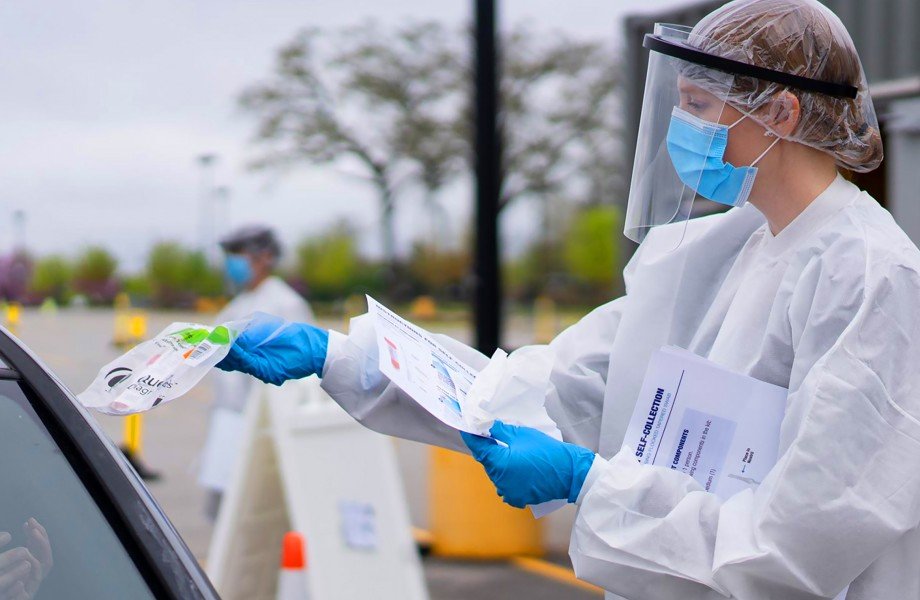
April 27, 2020
By Dan Bartlett, Executive Vice President, Corporate Affairs
On Thursday, March 12, we received a call from the White House asking Walmart to work with the U.S. Department of Health and Human Services (HHS) and other partners to stand up testing sites on our parking lots around the country. Since the start of the pandemic, one thing has been clear: Testing would be critical. So, when we got the call to help, the question wasn’t “if” – but “how.” We knew we could make a difference.
Service is in our company DNA, and when our communities need us, we are there. We put out a call to our team of problem solvers and were met with a resounding “YES, we can do this!” By 7 the next morning, hours before the Rose Garden announcement, a dozen members of our team had set up cones and tents on a parking lot, mapping out where people would be positioned and how cars would flow through.
The following Saturday, eight days later, a testing site opened to serve first responders in our Northlake store parking lot in the Chicago area. The site would open for testing at 10 a.m. that day. By 7 a.m., more than 100 cars were in line. The need was clear.

Over the next week, our operations were refined and improved. We could move cars through faster and, when the CDC expanded testing criteria to ultimately include anyone who was experiencing symptoms and any health care provider or first responder irrespective of whether they have symptoms, we were able to help even more members of the community. It was not without its challenges, including limits on personal protective equipment (PPE), which inhibited our ability to scale faster, but we worked through the issues as quickly as possible.
Evolving and Improving
Because none of this was the traditional role of a retailer, we pieced together how to run a testing site in the middle of a pandemic using two main principles to guide us: make sure everyone on site is safe; and provide a quality test. That means continuing to evolve and improve, to learn and iterate, and learn some more. And that’s exactly what we did at our first two sites in the Chicagoland area.
As a result of our learnings, phase 2 of the process began in early April with our lab partners, Quest and eTrueNorth. The new process allows individuals to register online in 5 to 10 minutes and significantly reduces the wait time. The test has also changed, from a pharmacist-assisted nasal swab to a self-administered nasal swab, observed by our trained pharmacists. But some things didn’t change: There is still no cost to the individual being tested (HHS and insurance are covering the cost of the tests). We also remained resolute on our position that everyone entering the site should be treated with care.

We are certainly not alone in supporting these sites. These sites reflect a coordinated partnership with our lab partners, local and state officials – especially the mayors and governors who have worked hand-in-hand with us – and HHS. Each site is supported by Walmart pharmacists who are paid volunteers; staff from our lab partners; security/law enforcement from the local community or state, including the National Guard; and volunteers from Remote Area Medical.
The model is working, but we continue to innovate and expand as we work to help more people, especially those in underserved areas. Once again we tasked our team with finding a solution. This week, Walmart is adding mobile testing sites to this critical mission, launching units in Georgia, Alabama and Kansas to better meet the needs of underserved populations and expand access to tests to even more Americans. These mobile units will bring drive-thru testing to several communities in each state, rotating between three to four different locations over the course of a week.
It’s been 45 days and counting since Walmart got the call to stand up testing sites, and we are now supporting 20 sites in 12 states – opening more every day. As a result, nearly 13,000 people have been tested at one of our sites to date. We have learned an incredible amount from these tests, and lab and testing capacity is increasing all the time, giving us confidence we can rapidly scale. Just this week, we will open approximately 25 more sites, and by the end of May we anticipate operating more than 100 sites, assuming there is adequate lab capacity. With 100 sites we can bring 20,000 tests a week to people who need them, especially in hot spots and underserved areas.
Continuing to Innovate
We are very proud of the work completed to get us to 45 sites, but we are anxious to do more and serve more communities where we are located (90% of the U.S. population is within 10 miles of a Walmart). To really accelerate our progress, we need to connect our next phase of testing with one of our core businesses – running a pharmacy.
As new tests emerge – including both nasal and saliva tests to identify if a person has the virus and blood-based (serology) tests looking for antibodies to determine if someone has recovered—and as testing capacity becomes more readily available and we can secure more kits—we can utilize our pharmacies across the country to distribute and collect tests at much greater volume. Imagine going online, scheduling a test through our lab partners, pulling up to your local Walmart at your scheduled time, parking in your assigned spot and having our pharmacist greet you. You take a nasal or saliva test while you remain in the car, and the test is sent to the lab for processing. For serology tests, perhaps you could even have your finger stuck by a pharmacist, similar to a test for blood glucose and cholesterol levels, to understand whether you have antibodies to the virus.

We are working now on how we might make this a reality. But that reality depends on many factors, including test availability, the approval of new tests by the FDA or approval of tests for broader types of use, whether state boards of pharmacy will expand the roles that pharmacists are allowed to play, and other considerations as we coordinate with state and local officials. Because we will have eliminated many of the barriers inherent in setting up large testing sites (e.g., security, use approvals, identifying needs), we can flex to rural, urban, metro, suburban and target underserved communities and hot spots going forward. Ultimately, we believe this new approach will allow us to be nimble, introduce new tests as there are advances and, over time, ramp up to even greater numbers.
But, whatever the model, we’re confident we will have a step change increase in the number of people we can test going forward.
Our People Make the Difference
As sites are stood up around the country, we’ve heard a common refrain from the associates supporting this testing. It’s a slight variation of a familiar theme: our people make the difference – and they sure love doing so. Walmart’s involvement is entirely donated, from our parking lot space to site supplies and materials to our associates’ paid time. We are supporting this effort because we all believe it is the right thing to do.

Hundreds of men and women at Walmart have stepped largely or completely away from their day jobs. An effort of this magnitude requires many hands – and we have teams of people in operations, health and wellness, public affairs and beyond to make these sites a reality. I am especially grateful to the Walmart pharmacists who volunteered to staff these sites. While we take every safety precaution to protect them, the work inherently puts them at increased risk, like many other health care professionals. Despite that risk, when it was first announced we would begin standing up these testing sites, within 48 hours more than 700 Walmart pharmacists and health and wellness associates volunteered to help. It’s just another example of how special our associates really are.
Supporting Efforts to Get Supplies to Health Care Providers
In addition to testing, another immediate challenge facing us as a country is the increased demand for medical supplies, especially PPE. So, we also are supporting efforts to get PPE and supplies to health care providers on the front lines where we can. As news outlets report, medical-grade PPE supplies have been challenged due to the significant need. We are tapping into our supply chain and apparel expertise to help McKesson source and deliver more than 2.5 million gowns and coveralls by the end of April. Looking ahead, we believe we can add another 6 million gowns into the supply chain in May, with millions more in June and beyond. We’re doing this important work in collaboration with McKesson, who has the ability to distribute these critical products to health care professionals across the United States. We also partnered with Salesforce and State Farm to provide 1 million masks, 100,000 gloves and 100,000 shoe coverings to health care workers in Michigan and Louisiana. In New York City, we donated approximately 50,000 masks to hospitals in need. And in California, when our stores found masks in their storage rooms left from last year’s wildfires, they worked quickly to donate approximately 3,600 masks to medical centers that serve underserved communities in Los Angeles County.
Unfortunately, COVID-19 will continue to challenge us over the coming months. We continue to monitor developments in technology, including new tests, to determine how they may play a role in our efforts, as we work to support our associates and our communities. I am inspired by the spirit and drive of my colleagues who are working hard to help meet the needs of the communities we serve. We will continue to find ways to help, just as we always do.


